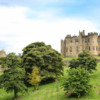The second largest inhabited castle in Britain today is Alnwick Castle in the town of Alnwick, in the north-eastern county of Northumberland. First mentioned in records in 1136, Alnwick Castle was built originally in to protect England's northern border against Scottish invasion. It was besieged in 1172 and again in 1174 but came close to demolition in 1212 when Eustace de Vesci, Lord of Alnwick was accused of plotting again King John, the then king of England.
In subsequent years, this enormous castle featured in almost every major war, rebellion, and Civil War that befell English nobility. Wikipedia tells us: "Henry Percy, 1st Earl of Northumberland (1341–1408), rebelled against King Richard II and helped dethrone him. The earl later rebelled against King Henry IV and after defeating the earl in the Battle of Shrewsbury, the king chased him north to Alnwick. The castle surrendered under the threat of bombardment in 1403. During the Wars of the Roses, Alnwick was one of three castles held by Lancastrian forces in 1461 and 1462. It was held against King Edward until its surrender in mid-September 1461 after the Battle of Towton." It's history is too much to try to detail here, but suffice it to say that it is a highly significant castle with a complex and fascinating history
Painted by the famous artist Canaletto in 1750 and landscaped by the acclaimed visionary Capability Brown in the 18th century, today some 200,000 visitors come to the castle each year to marvel at it's size, construction and history. The castle is in a particularly good state of repair and has been used as a location for a number of films including Harry Potter, Black Adder and Robin Hood - Prince of Thieves.
For a Picture of the Day, Alnwick is a wonderfully impressive slice of English history and absolutely warrants a visit from Travel Gumbo's adherents if they should be in the area.


Comments (2)